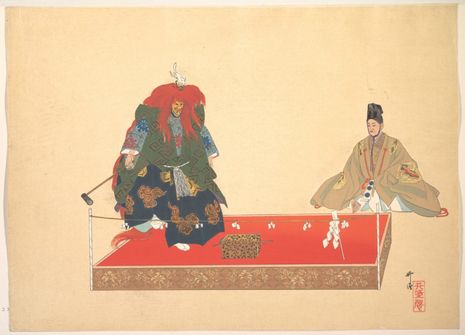The Puzzle of Japanese Noh Theatre
Margaux Emmanuel writes about her experience of this ancient form of Japanese theatre and what Noh means to her

Tokyo, November 2019: I ran through the streets of the Sendagaya district in pouring rain. Neon street signs were muffled in the dimness. Various Japanese characters were floating, reflected in large black puddles.
I was making my way to the National Noh Theatre. It was a building hidden away from the megalopolis; its architecture inspires tradition and austerity. I sneaked through Japanese men in business attire, women in kimonos, some theatre-goers queuing to have a quick bowl of soba before the performance started. In this place, far from the flashing city lights, the bustle and rush of trains, the eccentricity of Harajuku, I realized what Noh truly is: a dip into a timeless, other-worldly dimension.
I had been living in Japan for about a year and, the theatre-lover that I am, had been longing to see Noh. Considered the oldest form of theatre in the world, Noh is a part of the UNESCO Intangible Cultural Heritage. This type of theatre is characterised by the actors’ song-like voice and idiosyncratic masks; they are compelling large, pale faces - haunting, yet beautiful. These masks aren’t simply used for decorative or aesthetic purpose, they are the performative aspect of Noh.
Stock characters are signalled by the difference in characteristics of the masks in Noh. The actors are tasked with imbuing the expressionless mask with personality. Once the actor has donned the mask in a ritualistic manner, the actor becomes the character. The Japanese word for “to put on” is ”kaburu”, yet, in discussion of these masks, ”tsukeru" (to attach) is more commonly used; the mask becomes a bodily extension of the actor, the embodiment of the performance. It is also interesting to note here that the character for writing “Noh” (Nō) in Japanese is “能”, which is the character used in the word Sainō (才能), meaning talent. Noh is about skill.
The setting of the Noh theatre is always the same: there is a wooden, essentially bare, curtainless stage. There are no substantial props. A pine tree, symbol of an incarnated God that the Noh performance was usually for, is always painted on the back-panel. If the stage is bare, it means that the performance isn’t about performing a narrative, but is about the story the body of the actor and the mask tells. There are a number of techniques that the actor can use with this mask: he can terasu (lift the mask upwards) or kumorasu (tilt it downwards) to change its expression - to create joy or despondence. Not only are these masks materially valuable but they are symbolically priceless - pillars of a performance tradition unlike anything else in Western culture.
I entered the Noh theatre expecting that I wouldn’t understand the play (I had barely enough Japanese to order a rice ball from a shop attendant, so I was not expecting to understand 14th century Japanese. However, as I entered the theatre, I noticed screens with subtitles in modern Japanese (thankfully, in English too)). They reminded me of the screens in airplanes on long-haul flights.
Even at this first play, I could see that the audience of this play wasn’t here to just be part of a live story-telling spectacle, but to witness the aesthetic and ritualistic unravelling of tradition. Although Noh is mostly a historical or supernatural genre, it also consists of a comic interval called kyougen. Yet, no laughs came from the Japanese audience - the woman sitting next to me simply nodded with an appreciative smile.
“If the stage is bare, it means that the performance isn’t about performing a narrative, but is about the story the body of the actor and the mask tells”
Noh isn’t about relatability: it’s about distance and perhaps not understanding. This distance is symbolized in a very meta way with the masks themselves and the fact that the stage is curtainless, and bare. There is no illusion of reality to be upheld because Noh does not strive for suspension of reality but for the very opposite: Noh is an embodiment of the history and tradition that the Japanese are very much attached to.
It’s a common idea in Western theatre that part of an actor’s role (when things go wrong) is to improvise. However, Noh is about precision, every move choreographed, and heavily symbolic; it is an almost trance-like dance, where tradition is embodied, and resonates in every step. To act in Noh is the trademark of particular families - it makes the art a strict tradition, a preservation of the past. But Noh also clearly plays a significant role in the present, as a striking and effecting form of theatre.
 News / Cambridge study finds students learn better with notes than AI13 December 2025
News / Cambridge study finds students learn better with notes than AI13 December 2025 Features / Should I stay or should I go? Cambridge students and alumni reflect on how their memories stay with them15 December 2025
Features / Should I stay or should I go? Cambridge students and alumni reflect on how their memories stay with them15 December 2025 News / Uni Scout and Guide Club affirms trans inclusion 12 December 2025
News / Uni Scout and Guide Club affirms trans inclusion 12 December 2025 News / Cambridge Vet School gets lifeline year to stay accredited28 November 2025
News / Cambridge Vet School gets lifeline year to stay accredited28 November 2025 Comment / The magic of an eight-week term15 December 2025
Comment / The magic of an eight-week term15 December 2025








